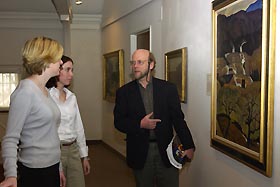|
This is an archived article. For
the latest news, go to the Advance Homepage
For more archives, go to the Advance Archive/Search Page. |
||
|
Students Find Geography Buried In Works Of Art
"Geology is everywhere, every day, if you know what to look for," says Thorson, a professor of geology and geophysics. Art is one of those places. Starting today, students in Geology 102 lab sections will view an exhibit at the William Benton Museum of Art. The exhibit, co-curated by Thorson and museum curator Thomas Bruhn, consists of 14 works of art selected to demonstrate a variety of places, subjects, artists, styles, and geological processes. According to Thorson, there is a wealth of geological information in art, particularly landscapes. "I wanted students to look deeper into the art to see the geology," he says.
Each piece is labeled with the geological process illustrated, such as glacial erosion, salt marsh deposition, and beach processes. Also included is information about the artwork, notes on the landscape geology, and references to illustrations in the course textbook. During their first time through the exhibit, students are asked to pause for a moment, and look at each image as art alone, Thorson says. The second time viewing the works, they are asked to read the geological notes while examining the image. They're also encouraged to compare the piece with artwork from their geology textbook, which is available for use in the museum's gift shop. During their third time through the exhibit, students are asked to think about whether an understanding of the geology has enhanced their artistic experience. One eye-catching photograph, "Olokun Priestess" by Phyllis Galembo, offers geological information that one would not usually notice, Thorson says. The woman in the photograph is wearing a white dress, bracelet, necklace, and ring and is standing in front of a stained stucco wall. She is holding a bell. The accompanying notes tell the viewer the stucco wall is composed principally of lime, stained by iron oxides derived from laterite soils. The shell necklace, iron bell, bronze ring, and gold jewelry are other earth materials, the notes say. An oil painting, "Blue Ridge Wilderness," made in the 1870s by William Lewis Sontag, appears to be a peaceful landscape with several fishermen. The notes read, "Take in the whole sweep here, but pay particular attention to the strandlines on the water, which must be lacustrine, rather than marine, because this is the Blue Ridge of the Appalachians, which is well inland from the sea." According to Thorson, in the course textbook: Earth: Portrait of a Planet, by Stephen Marshak, it is the science that comes first. "Each color photograph, painting, and graphic in the book serves the purpose of communicating science to the student," Thorson says. "In this exhibit, however, the priorities are reversed - art comes first, the geology second." The stop at the Benton is part of a class field trip called Geology in Everyday Life. In addition to seeing the artworks, students will stop at the landfill and at the cemetery on North Eagleville Road. "I want my students to see that geology spans the whole gamut - from groundwater pollution to fine art," Thorson says. "The cemetery, for instance, is simultaneously about soil, mortality, gravestones, and lovely, glacially molded hill." The exhibit, open to the public, runs until April 27. Museum hours are Tuesday through Friday, 10 a.m. to 4:30 p.m.; Saturday and Sunday, 1 p.m. to 4:30 p.m. |
 tudents in
Robert Thorson's introductory geology class will
soon put away the rocks and minerals to study fine art.
tudents in
Robert Thorson's introductory geology class will
soon put away the rocks and minerals to study fine art.

